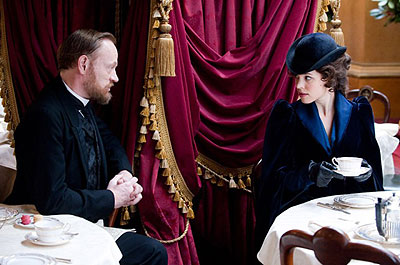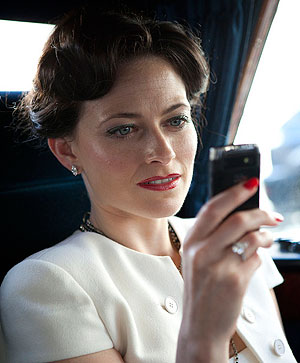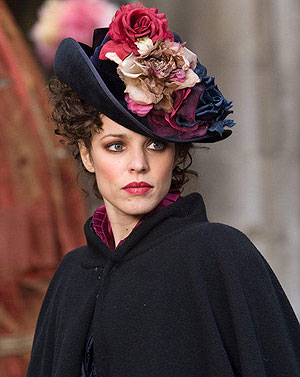Scandal In The 21st Century: The Different Faces Of Irene Adler
Published on January 30th, 2012 in: Books, Feminism, Issues, LGBTQ, Movies, Oh No You Didn't, TV |By Lisa Anderson
To Sherlock Holmes, she is always the woman. I have seldom heard him mention her under any other name. In his eyes she eclipses and predominates the whole of her sex. It’s not that he felt any emotion akin to love for Irene Adler. All emotions, and that one in particular, were abhorrent to his cold, precise, but admirably balanced mind . . . He never spoke of the softer passions, save with a gibe and a sneer . . . And yet there was but one woman to him, and that woman was the late Irene Adler, of dubious and questionable memory.
—”A Scandal in Bohemia,” by Sir Arthur Conan Doyle
In recent years, two new versions of the stories of Sherlock Holmes have captivated viewing audiences. One is the film version starring Robert Downey, Jr. The other is the BBC Television version with Benedict Cumberbatch as the lead. Both versions make good use of characters that have either been portrayed very differently or not used as extensively in other incarnations of Holmes stories. For example, both Jude Law and Martin Freeman portray John Watson as a much better sidekick than did Nigel Bruce and others. Mycroft Holmes, Sherlock’s smarter older brother, gets screen time and importance in both the movies and the television show. However, none of Arthur Conan Doyle’s characters has seen their stock increase more in these retellings than Irene Adler. SPOILERS BEHIND THE CUT!

Sherlock Holmes (Benedict Cumberbatch)
and Irene Adler (Laura Pulver)
Adler is played by Rachel McAdams in 2009’s Sherlock Holmes and its 2011 sequel, Sherlock Holmes: A Game of Shadows. Laura Pulver plays her in “A Scandal in Belgravia,” the first episode of Series Two of the BBC program Sherlock. Doyle wrote about her only in the short story “A Scandal in Bohemia,” and she is known as the only person ever to defeat Holmes.
In “A Scandal in Bohemia,” Sherlock Holmes is hired by the king of Bohemia to prevent his impending marriage from being derailed. Irene Adler, retired American opera singer and “adventuress,” possesses a picture of herself and the king that was taken while the two of them were romantically involved. Holmes follows her in one of his famous disguises, and ends up being drafted as a witness to her marriage. Later, Holmes concocts an elaborate ruse (with Watson’s help) to get her to reveal where she’s hidden the picture. When he returns later to claim it, he finds that she saw through his disguise and has absconded with the picture. In its place, she leaves behind a written promise not to bother the king . . . and a permanent impression in the mind of the consulting detective.

Sherlock Holmes: A Game Of Shadows
Moriarty and Adler
Chronologically, Sherlock Holmes takes place after the events of “Scandal in Bohemia,” and Watson alludes to them. As the story begins, Irene Adler is back in Holmes’s life, asking for his help in tracking someone down. She turns out to be working for a shadowy figure—Moriarty—of whom she is afraid. After the principal villain, Lord Blackwood, tries to kill her, she gets caught up in Holmes’s investigation and helps him and Watson for while. Then she, herself, ends up foiled by Holmes when she tries to steal dangerous technology for Moriarty’s benefit.
As the sequel, A Game of Shadows, opens, Adler is still working for Moriarty, and Holmes must stop their plans again. She disappears early on, though, and Moriarty later claims to have murdered her with a virulent strain of tuberculosis. This is ambiguous, however, as we never see her body and the “blood” on the handkerchief presented by Moriarty looks suspiciously like wine.

Laura Pulver as Irene Adler
“A Scandal in Belgravia” brings a thoroughly modern sensibility to the character of Irene Adler. She’s a dominatrix rather than a retired opera singer, and the pictures in question are of a female member of the royal family. They’re stored on Irene’s locked camera phone, along with a lot of other information that she considers insurance against her enemies. The plot of “Belgravia” is byzantine, involving Irene’s own fake death, Moriarty, and a terrorist attack which both the British Ministry of Defense and the American CIA are working to prevent. In the end, Holmes cracks the code on Adler’s phone, leaving her defenseless. As the episode wraps, Mycroft tells Watson that Adler has been executed by terrorists in Pakistan, but asks Watson to tell Holmes that she’s gone into witness protection. Out of consideration, Watson does so . . . but then there is a flashback of Holmes intervening to save Adler’s life.
Obviously, the Irene Adler of the movies is closer in her circumstances to the one in Doyle’s original story, being an adventuress rather than a dominatrix. In fact, I consider the choice to make Adler a dominatrix vaguely problematic, for the same reason that glossing over the career of Sibyl Vane is. In fairness, though, Pulver’s Adler is more like the way Doyle envisioned her in terms of strength. Both the movies and the TV program show Irene being rescued by Sherlock at least once, but McAdams’s Adler is written as somewhat hapless, never actually managing to stay a step ahead of Holmes or Moriarty, even though she thinks she is. Pulver’s Adler, on the other hand, is a effective strategist who takes measures for her own protection.
Sherlock is also more accurate in terms of how Holmes feels about Adler. In Doyle’s stories, Holmes had no romantic interests—in fact, many in the asexual community claim him as one of their own, in spite of the popularity of Holmes/Watson as a fandom pairing. He did, however, have a deep and abiding respect for Irene Adler. “In Scandal in Belgravia,” Benedict Cumberbatch does a wonderful job of conveying a potent mix of curiosity, admiration, and possibly even affection. His own romantic and sexual inexperience is mentioned several times in the episode, though, and while he enjoys sparring metaphorically with Adler, he never flirts back with her or accepts her advances. In Robert Downey Jr.’s portrayal, Holmes is clearly attracted to Adler, even though he has to put that aside for queen and country.

Rachel McAdams as Irene Adler
Both the BBC’s Irene and the Irene of the movies have feelings for Holmes, however. In the first Holmes film, McAdams’s Adler plainly admits that Holmes is her weakness, and that Moriarty uses him to manipulate her. In the newest film, Moriarty claims to have murdered her because those feelings compromised her effectiveness as one of his agents. In “Belgravia,” Holmes proves to be the Achilles heel for Pulver’s Adler as well. At one point, she claims that all her bold behavior—greeting him naked in her home, sending him text messages, propositioning him—was all manipulation and meant nothing to her. In a frankly quite sexy response, he documents all the physiological responses (her pulse, her breathing, the dilation of her pupils) that proved that to be untrue during their last conversation. The password to her phone turns out to be “S-H-E-R,” causing the screen to read “I am SHER-locked.”
Ironically, compromising feelings were no issue for Irene Adler in the short story. She was happily married, and showed no interest in Holmes. Her new husband wouldn’t be any happier to learn about her past than the king’s future wife would be to learn about his. This seems quaint today, when people are far more likely to accept the past relationships and youthful indiscretions of their partners. Rather than put Adler in this literally Victorian predicament, “Scandal in Belgravia” instead makes a very contemporary statement on sexual fluidity. “I’m not gay,” protests Watson, while he and Adler are discussing Holmes. “I am,” she replies.
Adler survives at the end of “A Scandal in Belgravia,” while her fate is left ambiguous at the end of Sherlock Holmes: A Game of Shadows. This leaves open the possibility of the character’s return in future installments. While both portrayals deviate from Doyle’s vision in important ways, I enjoyed them both, and would welcome either actress’s return to her franchise. The interplay between Sherlock Holmes and Irene Adler, both romantic/sexual and otherwise, added dynamic energy and a new twist to the stories being told. I hope that future retellings of Holmes stories will include the character he refers to as “The Woman.”
Time limit is exhausted. Please reload the CAPTCHA.